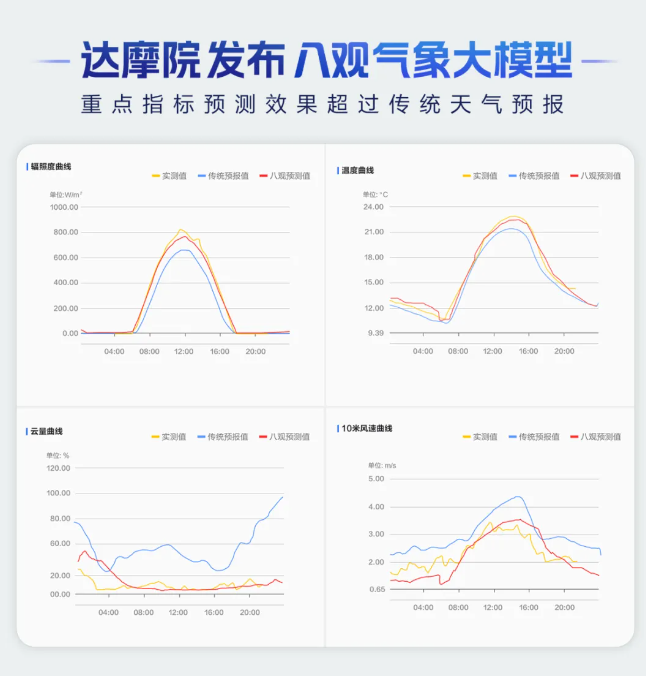Alibaba Damo Academy recently released its newly developed Eight View Meteorological Model. Based on the global meteorological model, this model integrates regional multi-source data to achieve unprecedented time and space accuracy: 1 km x 1 km and 1 Hourly update frequency. This marks a major breakthrough in meteorological prediction technology and will have a profound impact on many fields, especially the application in new energy power systems, which shows its powerful practical value.
Today, Alibaba Damo Academy held a decision-making intelligent product launch conference in Beijing and officially launched the Eight View Meteorological Model. Based on the global meteorological model, this model combines regional multi-source data, and can achieve a maximum temporal and spatial accuracy of 1 km x 1 km and 1 hour.

This innovative meteorological prediction tool has greatly improved the prediction performance of key meteorological indicators such as temperature, radiation, and wind speed. It has been successfully implemented in a new power system with a high proportion of new energy, significantly improving the power generation power and power load of new energy. The prediction accuracy rate reached more than 96% and more than 98% respectively.
The Decision Intelligent Laboratory of the DAMO Academy has built a regional high-precision weather forecast model based on its own global meteorological model. This model enhances the fine-grainedness and accuracy of forecast results by integrating local station data, meteorological liveness, radar images, satellite images and open source terrain and other data, and can achieve an hourly update of 1km meteorological forecast.
The Eight View Meteorological Big Model provides better initialization parameters through pre-training and twin MAE masking autoencoder structures, enabling learning robust feature representations hidden under high fluctuating weather data. With the increasing number of new energy installations and grid connections, the importance of accurate weather forecasts in the power industry is becoming increasingly prominent. Meteorological conditions will directly affect the output of photovoltaic and wind power generation, and also affect the electricity demand of residents.
Actual operation data show that the prediction accuracy of the Baguan meteorological model has increased by 40%, 27%, 24% and 11.8% respectively compared with mainstream weather forecasts in terms of regional irradiance, wind speed, cloud volume and temperature. In addition, the Baguan meteorological model will continue to improve performance in the future for key meteorological indicators such as cloud cover and precipitation, and strive to provide decision-making support for more scenarios such as aviation early warning, agricultural production, sports events, etc.
Key points:
The eight-view meteorological model launched by the Ali Damo Academy achieves high-precision meteorological predictions of 1 km x 1 km and 1 hour.
This model significantly improves the prediction accuracy of new energy power generation power and power load, reaching more than 96% and more than 98% respectively.
The prediction accuracy of the meteorological indicators of the Baguan meteorological model has been significantly improved in many fields, providing important support for power systems and other industries.
The accurate prediction of the Baguan meteorological model not only brings significant efficiency improvements to the new energy power system, but also provides more reliable meteorological data support for other industries. In the future, with the continuous optimization of the model and the expansion of application scenarios, it will contribute greater strength to social and economic development.